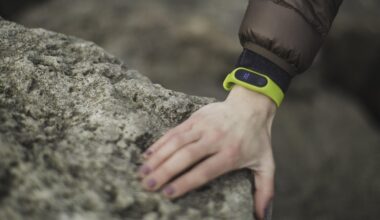Designing Resistance Bands Group Workouts for Kids and Teens
Creating effective resistance bands group workouts for kids and teens requires an understanding of their unique needs and preferences. Incorporating resistance bands can significantly enhance strength development in younger bodies, provided the training principles are adapted to suit their age and maturity levels. To start, securely anchor bands, ensuring safety at all times. Engage kids through fun, enticing workouts that keep them energized. Aim for a variety of exercises targeting complete muscle groups, such as squats, rows, and presses. Emphasize proper form to prevent injury while maximizing benefits. Make safety a priority, preparing for potential mishaps with proper instruction. Encourage participants to communicate any discomfort they experience while performing exercises, to ensure adjustments can be made. This builds a positive training environment, encouraging feedback and improvement. Additionally, involving kids in selecting exercises and workouts fosters ownership and interest in their fitness journey. Incorporate paired exercises to foster teamwork and collaboration. This engagement can also create a sense of camaraderie among participants, promoting social connections. Lastly, keep sessions short and focused to help maintain their attention and motivation.
Utilizing different resistance bands aimed at specific fitness levels can amplify the effectiveness of workouts. Choose bands with varying resistances to accommodate everyone, ensuring challenges are appropriate for their physical capabilities. For beginners, light resistance helps build confidence and familiarity with movement patterns. As they advance, gradually introduce heavier bands while keeping a balance between challenge and technique. Introductory challenges can incorporate fun elements such as timed circuits or team competitions. Group workouts can utilize thematic challenges, with friendly competitions enhancing both motivation and excitement. Furthermore, incorporate a range of exercises to keep workouts fresh and avoid monotony, allowing kids and teens to continuously explore the capabilities of resistance bands. Aim for a balanced mix of strength, agility, and flexibility-focused movements. Change up the routine periodically to maintain enthusiasm and encourage participants to try new forms of training. These adjustments can help develop adaptability in their workout mentality while reducing burnout. Encouraging participants to set personal goals fosters a sense of achievement, boosting motivation and sustained interest in fitness. Utilize check-ins to monitor progress, celebrate achievements, and make necessary modifications to workouts as they advance and develop their skills.
Engagement Strategies for Kids and Teens
Creating an engaging environment during resistance bands group workouts is crucial for retaining youth participants. Using motivational language, recognizing their efforts, and maintaining a positive atmosphere can enhance their experience. Implement visual cues and demonstrations that allow participants to understand each movement, ensuring they grasp the purpose behind various exercises. Break down complex movements into simpler components, making them more accessible and encouraging success. Allow autonomy by providing options where appropriate, empowering kids and teens to select varieties of exercises that resonate with their interests. This strategy enhances their self-esteem and promotes ownership of their fitness journey. Group dynamics play an essential role in motivating participants. Engage kids in buddy-based activities or small team competitions that promote interaction, creating enjoyable workouts. Gamifying elements is also highly effective in increasing enthusiasm, making challenges fun rather than just educational. Incorporate competitions that focus on teamwork and support, rather than individual performance alone. Celebrate collective successes to strengthen bonds amongst participants and instill a sense of pride in their commitment towards fitness. This community feeling lays the foundation for lifelong friendships, fostering a supportive network that keeps them returning for more sessions.
It is essential to include a proper warm-up and cool-down in every resistance bands group workout session. Warming up reduces the risk of injuries and prepares muscles and joints for rigorous activity. Encourage dynamic stretches that engage multiple muscle groups, gradually increasing heart rates while boosting enthusiasm. This helps kids transition into more intense movements without overwhelming them. Conversely, cooling down ensures they have time to recuperate and reflect upon their workout, enhancing recovery and mental processing. Implement static stretches after a workout session, allowing muscle relaxation and flexibility enhancement. Encouraging deep breathing during cool-down also aids in relaxation. Filling the gym space with enthusiastic music can also maintain high energy levels during sessions, reinforcing fun and engagement throughout the workout. Involve all participants in setting up the atmosphere, potentially allowing them to choose workout playlists or suggest themes. This fosters a sense of community and collective responsibility during workouts. Ultimately, providing a structure where the fitness goals can be achieved while still valuing enjoyment will result in a positive and successful experience for all participants in resistance bands group workouts.
Safety Considerations
Prioritizing safety in resistance bands group workouts is paramount, especially when working with kids and teens. Introduce essential safety protocols at the very beginning to set clear expectations. Educating participants about equipment handling and safety practices minimizes risks and ensures everyone understands their roles in maintaining a safe environment. Regularly inspect the resistance bands for wear and tear, replacing any damaged equipment immediately to prevent accidents. Also, teach participants how to properly secure their bands before commencing exercises or adjusting resistance levels. Including verbal cues can similarly guard against misalignment or overexertion. Implement the buddy system, where participants work in pairs for additional safety, while encouraging supportive feedback. This practice also builds trust and friendships, enhancing the group dynamic. Incorporate education about injury prevention, fostering awareness of their bodies and encouraging them to listen to feedback they receive during workouts. If anyone reports discomfort, exploring alternative exercises ensures safety while still allowing for effective training. Careful consideration of everyone’s needs and safety fosters a positive space where kids can thrive in their fitness journeys, minimizing risks and enhancing group workout experiences.
Adapting workouts to accommodate varying fitness levels is crucial in resistance bands group workouts. Each participant comes with different experiences, strengths, and limitations. Acknowledging their individuality promotes inclusiveness and helps maintain their motivation. Having multiple exercise variations for each movement allows facilitators to provide options tailored to individual capabilities. Beginners may perform simpler movements with lighter resistance, while advanced users can engage in more challenging exercises. Implementing scaling options, such as changing the position of resistance bands, can alter the intensity effectively. Encourage participants to find their comfortable range, setting achievable goals that contribute to their sense of accomplishment. Foster an environment where improving is celebrated regardless of progress pace, as all achievements matter. Encourage a supportive culture where advanced kids assist beginners, developing a bond and collaboration within the group. Ensure everyone’s voices are heard during planning discussions to encourage a sense of ownership regarding the workouts. Not only does this promote better acceptance of the procedures, but it enhances their commitment to the sessions. Ultimately, embracing diversity within the group gives each kid or teen a chance to shine while engaging in challenging yet enjoyable fitness activities.
Monitoring Progress and Feedback
Regularly monitoring progress and feedback is essential in resistance bands group workouts, allowing adjustments for optimal growth. Structured check-ins, ideally at the end of each month, provide key insights about each participant’s development, as well as their feelings about the workouts. Utilize tools such as fitness journals or activity trackers, helping kids document their engagement and perseverance within their fitness journeys. Celebrate personal bests, whether they involve increased repetitions or improved form, fostering a positive atmosphere around progress. Encourage kids to provide constructive feedback regarding exercises and group dynamics, focusing on creating an environment where their opinions matter. Facilitate open discussions about struggles faced during workouts and collaboratively look for solutions, enhancing problem-solving skills. This process involves kids in refining their workout experience while developing valuable communication skills. Additionally, implementing routine evaluations allows adjustments of future sessions to meet participants’ evolving needs. Establishing forums or group chats where kids can share experiences helps facilitate the exchange of motivational advice among peers, increasing overall enthusiasm. Ultimately, regular monitoring ensures group workouts are fulfilling and continuously tailored to maximize engagement and progress within children and teenagers alike.
The long-term success of resistance bands group workouts hinges on cultivating a positive culture surrounding fitness. Reinforcing the importance of physical activity while embracing the thrill of movement empowers kids and teens, positioning them as active participants in their health journeys. Celebrating their accomplishments regularly encourages continuous participation and commitment to future sessions. Incorporating fun and innovative exercises ensures workouts remain enjoyable, minimizing the potential for burnout or disinterest in fitness. Additionally, integrating relevant challenges, like themed workouts or friendly competitions, keeps energy levels high and participants excited. Informing parents about their children’s progress can boost motivation at home, as parental support plays a vital role in youth participation. Offering workshops or family events encourages communal participation in resistance bands activities, strengthening community bonds. Ultimately, creating a lasting impact involves establishing a framework centered on fun, growth, and relationships rather than mere metrics. This approach to fitness aids kids in developing healthy habits they can carry into adulthood, leading to long-term well-being. By prioritizing inclusivity and enthusiasm, resistance bands group workouts can foster a rich environment that nurtures enduring excitement and passion for fitness, empowering kids and teens alike.


